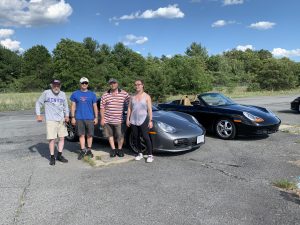Sim Racing may look really daunting from the outside looking in, but I definitely think it’s worth a try. You’re finally able to drive the cars you watch on tv and read about online. The only difference is you’re racing from the comfort of your own home and you don’t need to worry about the expense of crashing your GT3R 25 times in a row whenever Jeremy Mazzariello comes near you. For people who have never done sim racing, the investment of time, equipment, and the steep learning curve are hurdles to consider before taking the leap into sim racing.
Before I get into what I believe the key to improving is, I’ll tell you a little about myself. I’m a 16 year old boy from Andover Massachusetts, and a competitive swimmer. I train with my club team 20-30 hours a week, while attending high school. In a mere 3 hours or so a week of practice in the sim I’ve been able to improve vastly.
This past June I started off by borrowing Anker’s extra sim rig, consisting of an Oculus Rift and g29 wheels and pedals. I invested in the software and started buzzing around Lime Rock Park in my little Miata.
I sucked completely. I found new ways to crash that no one else has managed to recreate. But with time and practice I came third overall in my class for the Zone Group Challenge Championship earlier this month. And yes, I achieved this before even having my actual drivers license.
My family and I were all enthralled with how lifelike Lime Rock Park was, or I’d assume it’s lifelike since I’ve never been. (working on that) It was so realistic it even had the Harpoon sign!
Overall I think that the biggest thing for newcomers to understand is that there will be a steep learning curve. You need to adjust to the goggles/monitors, get used to the wheel and pedal setup you have, and in my case I had to learn how to drive a car. It took a week of struggle before I could finish 2 laps in a row on Lime Rock. Controlling your level of frustration is half the path to improving.
Once you can finish laps, go to every PCA session you have time for. In these sessions you need to ask one of the coaches to help you either through ride alongs or you hopping into their car. They are super helpful and will not judge you at all. For me I was very fortunate that I knew Anker from going to autocrosses with my dad. Anker got me right into the car with Chris Braun (one of our NER coaches) who helped me right away on my first practice. My first session was at Bathurst, which is a very hard track since there’s a lot of hills, hence the official name Mount Panorama.
That first lesson I had with Coach Braun was really difficult, he was using a lot of terms and concepts I was not familiar with yet. By the end of the session I could finish laps on Mount Panorama, and if he can stay calm with a 16 year old who couldn’t even get out of the pits without binning the car 4 times, he can stay calm dealing with anyone.
After those first few sessions you will improve like I did. After my first session I was about 15 seconds slower than the fastest people, second session I was about 10, then 7 and so on. Today, about 8 months later, I am about 2 or 3 seconds off on most tracks. So far in my sim racing journey the key to improvement has been to ask the coaches for help, it will pay off.
I hope that you reading this has helped influence your decision on whether or not to start sim racing. Sim racing has helped me immensely to learn car handling skills, which will be tested at Autocross next month. It also provides an awesome learning environment where you have nothing to lose. Iracing has allowed me to drive cars I likely will never be able to drive in real life, all on a lifeguard’s salary.
Please let your kids do sim racing. I’m lonely.
-Scott Kessel





